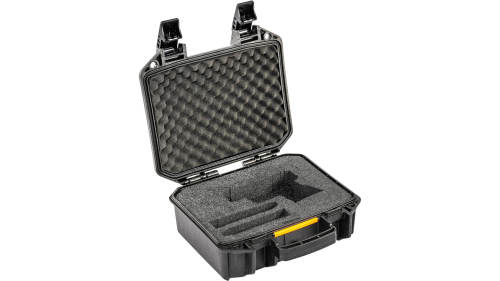For the last few years, I have been preaching to active and retired cops to go armed whenever they leave their home. The seminars I present across the country often require air travel, but I always try to practice what I preach.
One of the more common questions I’m asked at training seminars is how much of a hassle it is to bring along a pistol during air travel.
The simple answer is no real hassle at all — once you understand the process and prepare your gear.
Secure pistol case
I won’t cover the “on your person” airline carry process other than to convey one lesson I learned from doing several commercial airline prisoner transports back in my jail administrator days.
The old “Miami Vice” shoulder rig is the most comfortable holster for flying because airline seats are too narrow to comfortably accommodate a belt holster (unless you’re mighty skinny).
Also, many doctors recommend you get up and move about a bit to prevent blood clots from forming in your legs on long flights. Tight-fitting ankle holsters are likely to aggravate that issue.
Carrying a pistol and ammunition in checked baggage requires a bit of preparation. You will need a hard-sided, lockable container to secure your firearm in your checked baggage. The container can be a small, hard plastic or metal box with a dedicated lock or padlock, which you stuff in your soft-sided bag. Or, you can use a lockable hard-side piece of luggage, making the entire bag your “locked container.”
I use a small, metal NanoVault from GunVault inside a soft-side bag, using the vault’s cable to secure the weapon to the internal frame of the bag. Federal regulations require the container to be locked with a device that only you can open — with a key or combination — and NOT a “TSA lock.”
If you prefer to have your entire checked bag secured against unauthorized entry, you need lockable hard-side luggage rather than just a pistol case. Many of the tourist-grade hard bags are merely two thin shells, secured to each other with a fabric zipper — they can be opened easily with a knife.
Most of us are familiar with the nearly-indestructible hard-side gun cases from Pelican. They have a suitcase-sized model with wheels and a collapsible handle, which makes for great checked baggage (be advised that it is more expensive and heavier than a normal bag).
I know one firearms instructor who takes a couple of pistols when he flies and his “checked bag” is a heavy, metal ammunition can secured with a strong padlock and painted bright orange. The metal box bangs and clangs on the baggage claim conveyor, but his pistols in their soft cases arrive undamaged.
Simple procedure
When you arrive for your flight, you MUST check the bag containing the firearm and you MUST notify the desk agent the bag contains an “unloaded firearm.”
You will fill out an orange “weapon” card which must go INSIDE of the luggage. The policies require you to show the desk agent that the weapon is unloaded, but I’ve never been asked by a desk agent or TSA screener to show the weapon is unloaded — I imagine they simply don’t want the weapon exposed or handled in the airport.
Once the orange card is placed inside the bag, an airline agent will walk you and your bag to a TSA screener, who will generally have you open the luggage, wipe the contents for their detection system, and re-secure the bag. Your luggage then goes into the normal system, with no outward indication that it contains a firearm.
You can carry a “reasonable” amount of ammunition in the bag with the firearm in either the original factory packaging or a protected container. A loaded magazine is not considered a protected container unless the magazine is secured inside some sort of carrier.
I place the empty magazines inside the locked pistol case and carry my ammunition in its original factory box.
An invaluable benefit
I preach the “gunfighter” mentality in my seminars, so I practice what I preach and carry wherever I go. If you want to exercise your nationwide concealed carry rights under the federal LEOSA law, have no fear of flying with your weapon.
Just read the TSA and airline regulations for your carrier and get what you need to secure the weapon properly. The airlines are perfectly comfortable with guns in checked baggage — they deal with them all the time.
I haven’t found a way around the checked bag fee charged by most airlines — generally about $25 each way — but that is $50 well spent.
This article, originally published May 06, 2013, has been updated.
















